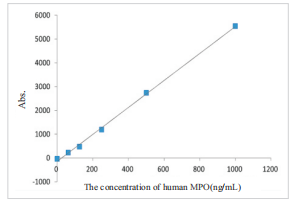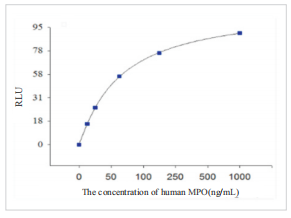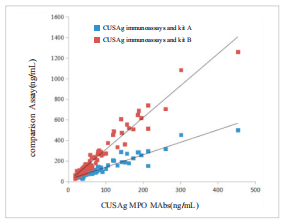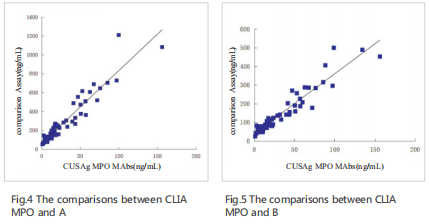Analysis of Cardiovascular Disease Marker---MPO
Views:906 Add time:2018-10-26 14:54:08
Myeloperoxidase (MPO) is a hemoprotein that is abundantly expressed inneutrophils and secreted during their activation.The 150-kDa MPO protein is a cationic homodimer consisting of two covalently bound subunits,eachconsists of aheavy chain (MW 60kDa) and alight chain (MW 15kDa).
MPO plays an important role ininflammatory response byzapping microorganisms anddestroyinga variety of target materials through catalyzing chloride ion oxidation to hypochlorous acid in thephagocytic cells. On the other hand, MPO causes oxidative modification of low density lipoprotein (LDL) to a high uptake form that is considered to be a key event in the promotion of atherogenesis. For this reason, MPO is believed to participate in the initiation and progression of cardiovascular diseases.At present, MPO is considered to be one of the most promising cardiovascularmarkers and the rise of MPO levels indicates the increased risk of atherosclerosis and coronary heart disease (CHD).
MPO level can be increased significantly within two hours for chest pain. Hence, MPO is an early warning marker of myocardial infarction and can be earlier to predict the risk of disease than troponin T, CK-MB and CRP. For patients with chest pain,MPO is then important and clinically significant in the diagnosis of Acute Coronary Syndrome (ACS).
Anti-MPO monoclonal antibodies
Two latest anti-MPO monoclonal antibodies (Catalog Number:CSB-DA406HmN①,CSB-DA406HmN②) have been developed by CUSAg.This product is sold forin vitro diagnosis.Anti-MPO monoclonal antibodies have beenrepeatedly tested in several aspects, such as accuracy, repeatability andstability by immunoturbidimetric assay and chemiluminescent immunoassay. What’s more, multiple clinical samples have been respectively tested byself-made anti-MPO antibodies andtwo domestic high-quality kits,the results show good correlationbetween them.
|
PROPERTIES |
SPECIFICATION |
|
Target species |
Human |
|
Host animal |
Mice Balb/c |
|
Cell line used for fusion |
Sp2/0 |
|
Immunogen |
Human myeloperoxidase |
|
Purification method, purity |
Protein G affinity chromatography,>90%(SDS-PAGE) |
|
Presentation |
MAb solution inNaCl with 15 mM NaN3 (pH 7.2) |
|
Application |
CLIA,LETIA,ELISA,GLCA |
|
Catalog Number: |
CSB-DA406HmN① CSB-DA406HmN② |
Product contains sodium azide as a preservative. Although the amount of sodium azide is very small, appropriate care must be taken when handling this product.
CalibrationCurve
LatexEnhancedTurbidimetricImmunoassay
The human MPO protein reacts with the anti-human MPOantibody coatedontolatex microspheres,resulting in agglutination and increase in turbidity. Thechangesin absorbanceare then measured using a spectrometer to quantitatively measure the MPO concentration in the samples.As shownin Figure 1,there is a significant linear correlation between the MPO concentrationand deltaabsorbance.

Fig.1 Thecalibration curve for MPO inimmunoturbidimetric assay
Chemiluminescent Immunoassay(CLIA)
The best two-sites MAb combination have been selectedfor the quantitative detection of MPO withdouble monoclonal antibody sandwich method, CSB-DA406HmN① as capture antibodies and CSB-DA406HmN② labeled with horse reddish peroxidase(HRP) as detection antibodies. The calibration curve betweenMPO concentration and relative light units is fitting byfour-parameter logistic model.(R2=0.9996)

Fig.2 Thecalibration curve forMPOchemiluminescentimmunoassay
Clinical comparison
Anti-MPO monoclonal antibodies were evaluated byimmunoturbidimetric assay in medium-scale clinical trials withrandom blood samples fromdonates (n=72). Fig. 3 shows the comparison ofMPOconcentrations determined viathe self-made antibodies and two high-quality kits (A and B). Results reveal good agreement between CUSAg immunoassays and comparison assays.

Fig.3 Comparisons of CUSAg MPO immunoassays and high-quality kits
Samples from donors containing the healthy and patients withmyocardial injury wererespectively detected using the CLIA MPO assays, A and B. CLIA MPO assays can distinguish healthy donors from patients. What’s more, the results show good correlation between CLIA MPO assays and comparison kits.

References
1. Klebanoff SJ (2005) Myeloperoxidase: friend and foe. J Leukos Biol 77,598- 625.
2. Nambi V (2005) The use of myeloperoxidase as a risk marker for atherosclerosis.Curr Atheroscler Rep 7(2), 127-131.
3. EZhang R, et al. (2001) Association between myeloperoxidase levels and risk of coronary artery disease. JAMA 286(17), 2136-2142.

